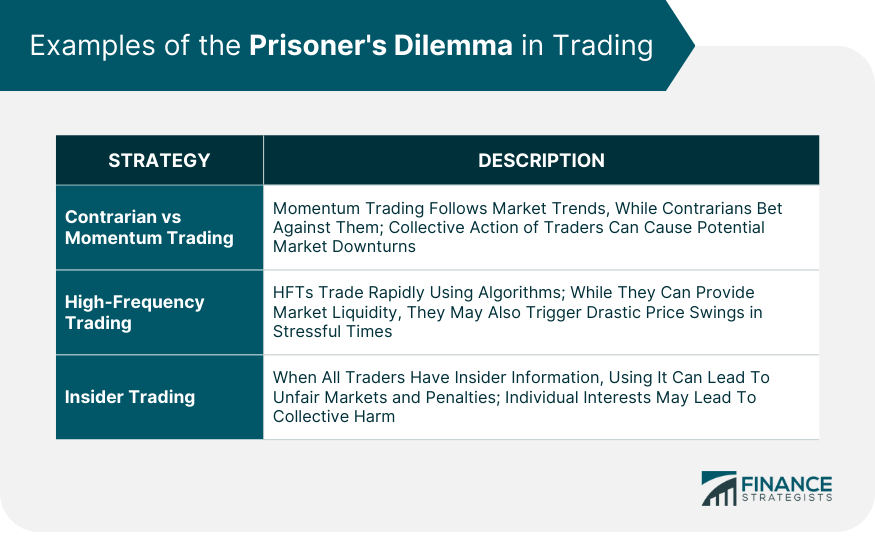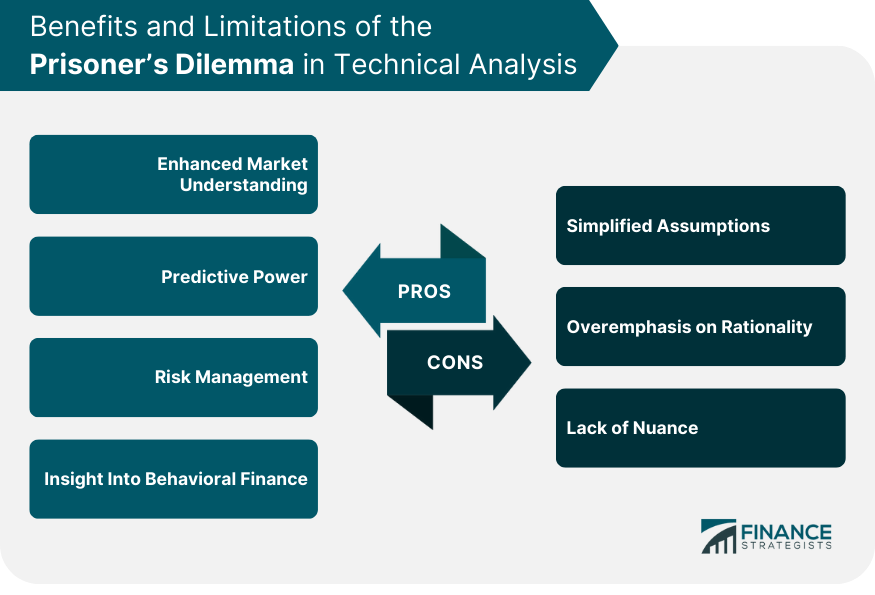The Prisoner's Dilemma is a canonical example of a situation in game theory in which individuals or entities, in an attempt to maximize their benefits, end up in a worse state than if they had cooperated. This scenario is illustrated by a hypothetical situation involving two prisoners isolated from each other, facing the dilemma of confessing or remaining silent. The dilemma arises from the tension between collective rationality (both prisoners remaining silent and obtaining a lighter sentence) and individual rationality (confessing to obtain a lighter sentence at the expense of the other). Just as it does in criminology, the Prisoner's Dilemma can provide a powerful illustration of certain financial scenarios. While finance lacks the simplicity and directness of the dilemma's original context, parallels can still be drawn. In financial markets, players continually face the decision to cooperate (e.g., maintain prices) or to defect (e.g., undercut prices), reminiscent of the prisoners' choice between silence and confession. In its classic form, the Prisoner's Dilemma is a non-zero-sum game where the two players choose between two options. Their choices lead to four possible outcomes with different rewards. If both players cooperate (equivalent to both prisoners remaining silent), they get a moderate reward. If one player defects while the other cooperates (one prisoner confesses while the other remains silent), the defector gets the highest reward (the confessor walks free), and the cooperator gets the lowest (the silent prisoner gets a long sentence). If both defect (both confess), they get a low reward, worse than mutual cooperation but better than being the only cooperator. The financial market often represents a Prisoner's Dilemma scenario, where market players can either cooperate for long-term mutual benefits or defect to secure short-term individual gains, potentially destabilizing the market. For instance, in a bullish market, traders could collectively maintain the upward trend by holding onto their stocks (cooperating). However, some might be tempted to sell (defect) to realize their profits earlier, potentially triggering a sell-off. Many scenarios in financial trading can be framed as Prisoner's Dilemma situations, where market participants are torn between short-term personal gains and long-term collective benefits. Momentum traders follow the current market trend (buy when prices are rising, sell when they're falling), essentially "going with the crowd." Conversely, contrarians do the opposite, betting against prevailing market trends. In a rising market, momentum traders can collectively profit by buying more, thus helping sustain the bullish trend. However, some traders might be tempted to adopt a contrarian approach, selling off their positions to realize their profits early. If enough traders adopt this contrarian strategy, it could trigger a market downturn, leading to a situation where everyone suffers, analogous to the sub-optimal outcome in the Prisoner's Dilemma. High-frequency trading (HFT) offers another illustration of the Prisoner's Dilemma in financial markets. HFTs use advanced algorithms to trade securities at lightning-fast speeds, often creating and liquidating positions within milliseconds. While these HFTs can provide liquidity to the market, they can also cause drastic price movements in times of market stress. For example, suppose an unfavorable news breaks out, causing some market participants to sell their positions. In that case, HFTs may exacerbate the situation by rapidly selling off their holdings, potentially triggering a market crash. While each HFT is acting in its best interest, their collective actions could lead to detrimental outcomes for the market as a whole - a clear parallel to the Prisoner's Dilemma. Insider trading can also be seen as a Prisoner's Dilemma. Imagine a situation where all traders have insider information. The ideal scenario for market integrity would be if no one uses this information. However, individual traders face a choice: if they refrain from using the information while others do, they miss out on potential profits. Thus, they might be tempted to use the insider information, leading to an unfair market and potential regulatory penalties. This situation represents a form of the Prisoner's Dilemma, where pursuing individual interests can lead to negative outcomes for all. The Prisoner's Dilemma can enhance the understanding of market dynamics. It helps explain why market participants might behave irrationally or against the collective interest, leading to unexpected market movements. With this insight, technical analysts can better interpret market trends and patterns. If a situation in the market parallels the Prisoner's Dilemma, traders might anticipate that participants will act in their own interest, even if it's not the best decision for the collective. This understanding could inform decisions about when to enter or exit positions. The Prisoner's Dilemma can provide insights into market risks. For instance, understanding that market participants might act out of short-term self-interest, leading to market instability, can help traders develop better risk management strategies. They can adjust their positions or use hedging strategies to protect their portfolios against sudden market swings. This field studies how psychological influences and biases affect the financial behaviors of investors and practitioners. These insights can complement technical analysis by helping users understand the psychological factors driving market movements, leading to more comprehensive and robust trading strategies. The Prisoner's Dilemma is a simplified model with only two players making a single decision. In contrast, financial markets consist of countless participants making numerous decisions over time. Thus, the Prisoner's Dilemma might oversimplify market dynamics and fail to capture all the complexities involved in real-world trading. The Prisoner's Dilemma assumes that participants are perfectly rational and will always act in their self-interest. However, behavioral finance shows that traders are often influenced by cognitive biases and emotions, leading to decisions that deviate from pure rationality. Thus, the Prisoner's Dilemma may not always accurately represent trader behavior. The Prisoner's Dilemma presents a binary choice between cooperation and defection. However, in financial markets, decisions often involve more nuanced strategies rather than stark either-or choices. Traders can partially cooperate or defect, and their decisions can vary based on the specific context and their risk tolerance. The Prisoner's Dilemma highlights the tension between short-term individual gains and long-term collective benefits, shedding light on the potential risks and suboptimal outcomes that can arise when participants prioritize personal interests over cooperation. By recognizing the parallels between the Prisoner's Dilemma and financial decision-making, traders and analysts can gain valuable insights into market dynamics, improve risk management strategies, and enhance their understanding of behavioral finance. However, it is important to acknowledge the limitations of the Prisoner's Dilemma when applied to real-world financial markets. Its simplified assumptions and focus on rationality may overlook the complexities and nuances involved in actual trading, where countless participants make a multitude of decisions over time. Moreover, human behavior in financial markets is influenced by cognitive biases and emotions, which may deviate from the purely rational assumptions of the Prisoner's Dilemma. As a result, while the framework offers valuable insights, it should be used in conjunction with a comprehensive understanding of market dynamics and individual trader behavior to make more accurate predictions and develop effective trading strategies.What Is the Prisoner’s Dilemma?
Prisoner’s Dilemma in Context
Game Theory
Analogy to Financial Market Decision-Making
Examples of Prisoner's Dilemma in Trading
Contrarian vs Momentum Trading
High-Frequency Trading
Insider Trading

Benefits of Prisoner’s Dilemma in Technical Analysis
Enhanced Market Understanding
Predictive Power
Risk Management
Insight Into Behavioral Finance
Limitations of the Prisoner’s Dilemma
Simplified Assumptions
Overemphasis on Rationality
Lack of Nuance

Final Thoughts
Prisoner's Dilemma FAQs
The Prisoner's Dilemma serves as an analogy for decision-making in financial markets. It highlights the conflict between short-term individual gains and long-term collective benefits, similar to the dilemma faced by prisoners choosing between confessing and remaining silent. In finance, market participants often face the choice of cooperating for mutual benefit or defecting to secure personal profits, potentially destabilizing the market.
Applying the Prisoner's Dilemma to technical analysis offers several benefits. It enhances our understanding of market dynamics, helping explain irrational behavior and unexpected market movements. Additionally, it can provide predictive power by anticipating participants' self-interested actions even when it may not be in the collective's best interest. The Prisoner's Dilemma also assists in risk management, as recognizing the potential for short-term self-interest to destabilize the market allows traders to develop better strategies to protect their portfolios.
Momentum and contrarian trading strategies often reflect the Prisoner's Dilemma in finance. Momentum traders follow the prevailing market trend, buying when prices are rising and selling when they're falling, essentially "going with the crowd." On the other hand, contrarians take the opposite approach, betting against the prevailing market trends. In a rising market, momentum traders can collectively profit by buying more, sustaining the bullish trend. However, some traders may defect from cooperation and adopt a contrarian approach, potentially triggering a market downturn that affects everyone, similar to the suboptimal outcome in the Prisoner's Dilemma.
The Prisoner's Dilemma offers insights into behavioral finance, which studies how psychological influences and biases affect financial behaviors. By recognizing the conflict between individual rationality and collective rationality in the Prisoner's Dilemma, analysts can understand the psychological factors driving market movements. This understanding contributes to a more comprehensive understanding of trader behavior, allowing for the development of robust trading strategies that consider the biases and emotions that impact decision-making in financial markets.
Traders can mitigate the limitations of the Prisoner's Dilemma by adopting a comprehensive approach that considers both the framework's insights and a broader understanding of market dynamics. This includes incorporating fundamental analysis, technical analysis, and risk management strategies. By recognizing the limitations and nuances of the Prisoner's Dilemma, traders can develop more informed and well-rounded strategies that align with their specific trading goals and the complexities of real-world financial markets.
True Tamplin is a published author, public speaker, CEO of UpDigital, and founder of Finance Strategists.
True is a Certified Educator in Personal Finance (CEPF®), author of The Handy Financial Ratios Guide, a member of the Society for Advancing Business Editing and Writing, contributes to his financial education site, Finance Strategists, and has spoken to various financial communities such as the CFA Institute, as well as university students like his Alma mater, Biola University, where he received a bachelor of science in business and data analytics.
To learn more about True, visit his personal website or view his author profiles on Amazon, Nasdaq and Forbes.











